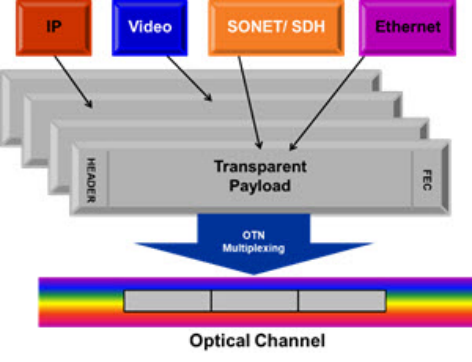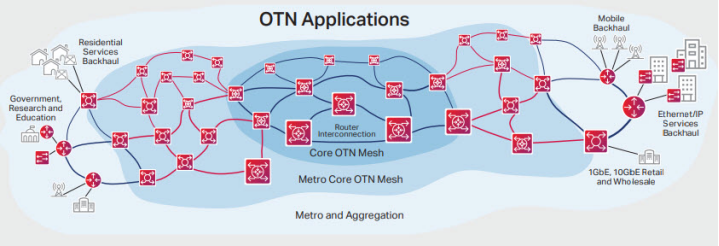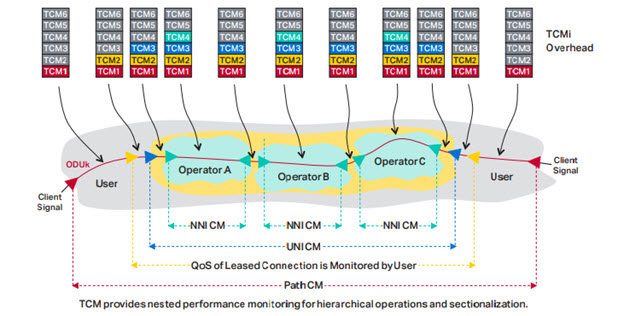
Data Center Interconnect (DCI) technology connects two or more data centers together over short, medium or long distances using high-speed packet-optical connectivity.
Optical Transmission Network (OTN) is a standard protocol in the telecommunications industry, defined in various recommendations of the International Telecommunication Union, such as G.709 and G.798. It provides an effective way to transmit, exchange, and multiplex different services onto high capacity wavelengths on optical networks. Today, network providers rely on OTN supporting technologies in their optical networks to gain benefits, including enhanced flexibility, simplified operations, enhanced Service-level agreement (SLA), extended forward error correction (FEC) coverage, and the ability to effectively maximize wavelength filling and guaranteed end-to-end service delivery.
OTN is usually called "digital packaging" because it transpares each client/service into a container to transmit it on the optical network, thereby retaining the local structure, timing information and management information of the client. OTN enhanced multi -way reuse capabilities allow different business types, including IP, Ethernet, storage, digital videos, and SONET/SDH, and transmitted through OTN frame structures. This is the key reason for using OTN.

Figure : The Optical Transport Module (OTM) is the information structure
OTN technology in optical networking
As shown in the figure, OTN technology is used in various ways in the optical network. OTN mapping or packaging is used to provide high -width -wide agile photon connections. For example, today's coherent regulators use OTN to mappore to transport customer service on high -capacity coherent waves. Today, the widely deployed pronunciation uses OTN to map the client to the multi -road reuse (DWDM) channel with dense wavelengths.
OTN is also widely deployed in a network with module -based or central structured OTN hardware. OTN MUXPONDER reuses a low -speed client on multi -road to a hardware module or a DWDM channel in a compact platform, thereby achieving the point -to -point connection of cost benefits. The total rate of MUXPONDERS has a low total rate service and is used to transport multiple 100GE/400GE services in a compact DCI platform.

Larger networks in the metro and core consisting of many nodes that are interconnected together can use an OTN centralized fabric, which again multiplexes (or grooms) lower speed clients onto a DWDM channel. However, it is by way of a back-plane cross connect or fabric.

Key operator benefits
Today, operators have obtained a competitive advantage from the significant advantages provided by OTN, including improving performance, simplifying operations, faster service turntables, maximizing efficiency and differentiated services through the long -term error correction (FEC). Therefore, operators can use the next -generation technology to achieve a programmable optical infrastructure to quickly respond to the unpredictable bandwidth requirements today. Let us discuss some of the key advantages in detail.
Improve performance through FEC. The key advantage of OTN is that it defines the FEC scheme without a signal before transmission. FEC has greatly improved the tolerance of network obstacles in high -capacity transmission, and corrects and detect errors in optical links. FEC is used to significantly increase the system border between the given bit error rate (BER) and signal power, which allows a longer span in the network. This enables providers to expand the distance between optical relay, which helps reduce capital and operating costs, while simplifying the network terrain to skip the amplifier site.
Simplified operations and enhanced SLA. OTN provides service guarantee and faster fault exclusion function, including topology tracking, error detection and fault isolation/correlation.
Built -in real -time delay measurement. In many applications, it is the most important requirement to meet the maximum delay SLA. Delay measurement is the native OTN, which can be used to ensure SLA compliance.
Witnene service surveillance. OTN includes the local traffic surveillance solution (with functions such as TCM), which allows this function to monitor end -to -end service surveillance on multiple domains, as shown in the following Figure.

Conclusion
OTN can achieve high flexibility on the network, scalable and any connection on demand. As a result, the fiber capacity can be maximized by effective use of high -capacity next -generation related wavelengths.





 INQUIRY
INQUIRY